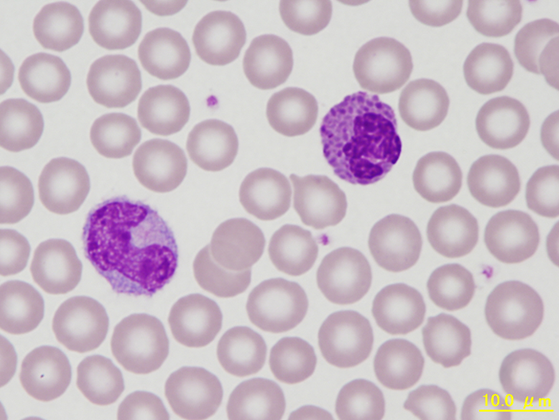Images scientifiques

Typical pictures of a lymphocyte, monocyte and a neutrophil (top down). In the monocyte vacuoles overlap with the nucleus leading to the appearance of holes in the nucleus. The segments of the neutrophil nucleus are linked through nuclear filaments.
<p>Typical pictures of a lymphocyte, monocyte and a neutrophil (top down). In the monocyte vacuoles overlap with the nucleus leading to the appearance of holes in the nucleus. The segments of the neutrophil nucleus are linked through nuclear filaments.</p>

Lymphocyte to the left and segmented neutrophil to the right. Note the different chromatin patterns of the nuclei of the two cell types.
<p>Lymphocyte to the left and segmented neutrophil to the right. Note the different chromatin patterns of the nuclei of the two cell types.</p>

The lymphocyte on the upper right shows many azurophilic granules. Adjacent to the lymphocyte on the left there is a monocyte containing numerous vacuoles.
<p>The lymphocyte on the upper right shows many azurophilic granules. Adjacent to the lymphocyte on the left there is a monocyte containing numerous vacuoles.</p>

Neutrophilic myelocyte with many azurophilic granules in comparison to two mature, segmented neutrophils. Immature blood cells are an occasional finding in the peripheral blood of marmosets.
<p>Neutrophilic myelocyte with many azurophilic granules in comparison to two mature, segmented neutrophils. Immature blood cells are an occasional finding in the peripheral blood of marmosets.</p>

Marmoset blood smear showing a neutrophil with segmented nucleus and granules that appear eosinophilic. The red blood cell to the left contains a Howell-Jolly body, a common finding in the marmoset.
<p>Marmoset blood smear showing a neutrophil with segmented nucleus and granules that appear eosinophilic. The red blood cell to the left contains a Howell-Jolly body, a common finding in the marmoset.</p>

Typical neutrophil, lymphocyte (centre) and monocyte (bottom) of a marmoset. At the top there is an erythroblast showing condensed chromatin and a greater amount of slightly reddish cytoplasm reflecting haemoglobin synthesis. Giant platelet between the neutrophil and lymphocyte.
<p>Typical neutrophil, lymphocyte (centre) and monocyte (bottom) of a marmoset. At the top there is an erythroblast showing condensed chromatin and a greater amount of slightly reddish cytoplasm reflecting haemoglobin synthesis. Giant platelet between the neutrophil and lymphocyte.</p>


